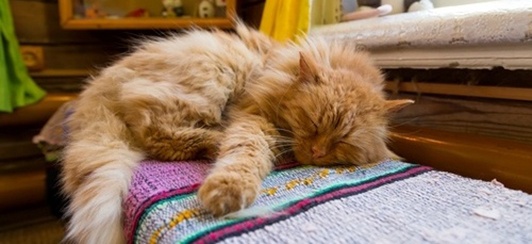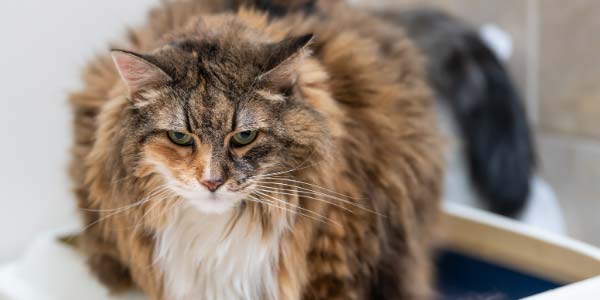- en
You may be wondering if you can make a difference in your cat’s life if they have arthritis. The simple answer is – YES!
The information below will help you know what to do and how to help your kitty feel more comfortable.
Quick Links

Cats are masters at disguising pain. It's a survival instinct.
Important note: When touching your cat to see if they're potentially in pain, there is a chance that you or someone helping could get bitten or scratched. Even if your cat would never normally bite or scratch, the mere fact that you're checking them for pain gives them the idea that something's up!
Our mission is to help save dogs' and cats’ lives through our educational content. To support our efforts, this page may contain affiliate links. We earn a commission for qualifying purchases – at no cost to you.
Arthritis, sometimes called osteoarthritis (OA) or degenerative joint disease (DJD), is a degenerative, progressive, and irreversible worsening of inflammation of the joint that causes damage to the surrounding cartilage and bone. In a healthy feline joint, the cartilage acts as a cushion to allow a joint to move smoothly in a full range of motion. In an arthritic joint, that cushion is worn down, resulting in pain, inflammation, and decreased mobility. Arthritis in cats is very common, with it being the worst among older or senior cats. Cats develop arthritis most frequently in the elbows and hips, but it has also been reported in their shoulders, knees, wrists/ankles, and spine. Very typically, joints are affected bilaterally (this means that the same joint on the opposite side will have arthritis). Besides, feline obesity playing a role in developing arthritis, dislocation, trauma, or infection of the joint can lead to arthritis at any age.
Unlike dogs, cats can often tolerate or hide severe arthritis due to their small size and natural agility. In addition to this, cats resist physical manipulation and handling during examination by a veterinarian. Their general behavior during an exam makes it hard to determine if they are showing signs of pain or just resistance. Therefore, it often goes undiagnosed.
Arthritis tends to be a complex condition that involves both inflammation and degeneration of the joint. Unfortunately, there isn’t one single cause but rather several things that influence the development and progression of the disease. Some of those factors include body conformation (how the cat is built), obesity, abnormal joint development, orthopedic surgery, trauma or injury, and nutritional issues. About 90% of cats over the age of 10 have arthritis in at least one joint.
Certainly, obesity – due to the degree of constant, low-grade inflammation that it creates in a cat's entire body – is a significant contributing factor to the development of arthritis, as is poor nutrition.
Any repetitive activity with uneven weight loading or distribution can lead to degeneration. Cats repeatedly leap and jump on and off things – a likely reason that the elbows and hips are one of the most common locations affected. Cats are also climbers and have a tendency to extend their bodies up on cat towers or similar vertical structures. This puts a repetitive strain on their hips and spine. Constant kneading at cat posts adds to the issue of arthritis too.
Any inflammation in the body, especially chronic inflammation from immune-mediated diseases, can lead to arthritis as well.
Unfortunately, with arthritis, you aren't "treating," but more so "managing" the disease. Your veterinarian will likely recommend that your cat maintain an ideal body weight and an active lifestyle. These are the two best ways to combat and slow the progression of osteoarthritis.
There are special diets that are designed to help in the management of arthritis (Royal Canin Mobility Support and Hill's j/d). Remember to follow the guidelines your veterinarian has recommended to you regarding how much you should feed.
Your vet will also likely recommend specific supplements or herbal extracts, medications, and a tailored exercise regimen to keep your cat comfortable. You must follow these recommendations closely.
Note: As mentioned earlier, diagnosis can be difficult in a cat since they aren't always cooperative during an exam. They do not typically have the same obvious signs, such as crepitus or grinding of joints that dogs do. Therefore, your veterinarian may recommend a treatment trial to see if they respond.
In advanced cases, additional medications and therapies may be helpful, including injections into the joint or those designed to prevent cartilage breakdown, laser therapy, platelet-rich plasma, stem cell treatments, physical therapy, and acupuncture.
Arthritis is a painful and uncomfortable disease. If your cat is diagnosed with arthritis, keep in close contact with your veterinarian and be sure to administer medications as directed.
Read more tips, details about the products mentioned above, and supplement suggestions.

After your cat has been diagnosed with arthritis and has been started on medications, you should notice that your feline companion is moving better and is less painful. You will also notice your cat's mood improve!
Medications should reduce inflammation and pain and improve your cat's range of motion in the affected joints. Your kitty should be able to move and play with ease and seem more active overall.
If your cat has not made any improvements during the first two to three weeks of medications, it is time to talk to your veterinarian. Your veterinarian may require additional testing or perhaps prescribe additional pain meds to keep your cat as comfortable as possible. During this period of time, monitor your cat closely. Their behavior and habits at home are very different than they are at the vet’s office. It is recommended to video your cat walking or moving or doing anything that seems abnormal to you. This can help your veterinarian diagnose your cat better.
The Pet InfoRx® is made possible, in part, through our partnership with AlignCare®.


© Preventive Vet. All rights reserved. PreventiveVet.com
